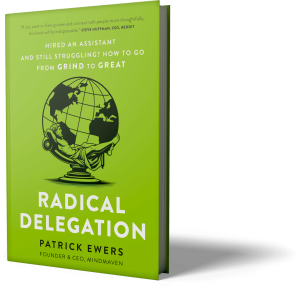
“Meetings should be like salt: A spice sprinkled carefully to enhance a dish, not poured recklessly over every forkful. Too much salt destroys a dish. Too many meetings destroy morale and motivation.” – Jason Fried (@jasonfried), Basecamp founder and CEO
1860 minutes.
According to Atlassian, the average person spends 31 hours, or 1860 minutes, in meetings each and every month. That’s about 62 30-minute meetings.
That’s a lot of meetings, but I’d be willing to bet that many of you exceed those numbers on a regular basis. If that sounds like you, here’s the question you’ve got to ask:
How many of those back-to-back meetings were truly productive?
In my experience, and the experience of many of my clients, less than 50% of the commitments made during external meetings are followed through on. And if commitments aren’t being fulfilled, the meetings they were made during aren’t only less productive; they can be downright damaging.
What makes this tendency even more dangerous is that it’s usually accidental. Few people schedule a meeting or make a commitment intending not to follow-through; but the reactive chaos of our day-to-day lives often makes this an inevitability.
Let me illustrate how this happens.
The Chaos of Back-to-Back Meetings
You arrive at the office at 8:00am with a calendar packed full of back-to-back meetings; meetings scheduled so close together you hardly have time to run to the bathroom before you’re off to the next one.
By 8:00pm that night, you’re exhausted. You’ve spent the last 12 hours in (or on your way to) a blur of back-t0-back meetings. You hardly remember your last meeting, let alone the first and, despite working hard all day, it feels like the only thing you accomplished was adding more to your plate.
Regardless of how positive some of those meetings might have been, you can’t help but feel overwhelmed by the sheer amount of new commitments and obligations made; many of which you may have already forgotten.
Sound familiar? If your calendar is regularly booked back-to-back, it might be time to rethink your meeting management approach. But before we talk about the solution, let’s take a look at what causes the problem in the first place.
The Cause of Back-to-Back Meetings
What causes people to put themselves through the stress of back-to-back meetings? In most cases, it’s the misguided belief and feeling that by squeezing in more meetings, they’re being more productive. But, as most of us have probably experienced, that’s rarely the case. In fact, the opposite is usually true. Here’s why:
For every meeting you attend, you usually have at least one new commitment. And seeing as you probably entered that meeting with an already-full to-do list, the chance of actually following through on that commitment in a timely fashion is relatively low.
But that’s only half the problem.
The nature of back-to-back meetings often causes us to focus on things that are reactive and urgent throughout the entire rest of the day. But as we’ve discussed before, the things that truly move your business forward are rarely urgent and reactive; they’re important and proactive. But, unfortunately, urgency almost always trumps importance.
So when you spend 80%+ of your day in meetings, that only leaves ~20% of your day for the things that are truly important. And more often than not, that 20% is at the end of the day, when your brain is exhausted and your creative thinking (a vital part of successful entrepreneurship, says Hootsuite’s Ryan Holmes (@invoker)) is compromised.
I think many of you will agree: This isn’t sustainable. If you want to master peak productivity and reach your full potential, you need to be more intentional with your time and your commitments.
Let’s take a look at two strategies to do just that.
#1: Find Balance with a Meeting-to-Proactivity Ratio
There’s a “golden rule” for productivity you’ve probably heard before that goes something like this: Never schedule more than half your day with meetings.
And if that’s a rule you’re able to adopt, great! It provides a strong balance between proactivity and reactivity. But for a lot of people, that simply isn’t realistic.
You don’t necessarily need a 50/50 split, but you do need to find (and enforce) a balance that works for you. One of the best ways I know to find and maintain that balance is what I call a Meeting-to-Proactivity Ratio.
A Meeting-to-Proactivity Ratio is a simple number that dictates how much time you spend outside meetings for every hour you spend in one.
For example: The “golden rule” of productivity would have a ratio of 1:1; meaning for every one hour you spend in a meeting, you should spend an hour on something proactive.
This proactive time can be used for anything that doesn’t involve actually attending a meeting, though you can use it to prepare for future meetings or catch up on the commitments made in prior meetings. Here are a few examples of proactive work from The Definitive Guide to Understanding Proactivity and Becoming a Proactive Entrepreneur:
- Developing strategic goals to make the upcoming year successful and productive,
- Creating a compelling list of reasons why a specific feature is important for your product in order to move the company in that direction, or
- Writing a blog post to develop thought leadership in your market.
Need a place to start? If a 1:1 ratio isn’t realistic for your line of work, start with 1:0.5. With this ratio, you would spend half an hour outside of meetings for every hour spent in one.
Want to learn more about how to actively schedule and enforce proactive time investments? Download our free book: Whitespace Time Management: The Proactive Entrepreneur’s Guide to Owning Your Time and Mastering Your Priorities
#2: Hack Your Meeting Length
Forgive me for stating the obvious, but: If you don’t want back-to-back meetings, don’t schedule back-to-back meetings.
Don’t get me wrong: I know that, for many of you, meetings are an integral (and unavoidable) part of doing business. But what if you could schedule the same number of meetings without scheduling them back-to-back (and without extending your workday well into the night)?
You can, and all it takes is a small tweak: Change the length of your meetings.
- In most cases, the standard length for long meetings is 60 minutes. Make them 50 minutes
- In most cases, the standard length for short meetings is 30 minutes. Make them 25 minutes
As James Altucher (@jaltucher) points out in The Six Things The Most Productive People Do Every Day, “most meetings can be summarized in a two line email.”
That may be a little extreme for your situation, but I’d be willing to at least bet that whatever you cover in a 60-minute meeting could be covered in 50 minutes, and whatever you cover in a 30-minute meeting could be covered in 25 minutes.
And while an additional 5-10 minutes might not seem like much, that small window of time can make all the difference. Not only do you now have time to find a bathroom in-between meetings, you also have time for important tasks like:
- Performing a Meeting Debrief to ensure you follow through on every commitment made, and
- Preparing for your next meeting by leveraging past Meeting Debriefs and utilizing powerful relationship marketing tools.
Those two practices are often all it takes to turn an unproductive meeting into one that deepens relationships, increases mindshare, and generates valuable opportunities.
How to Shorten Your Meetings
Unless you want to risk offending the people you’re meeting with, don’t start scheduling shorter meetings without warning; otherwise, you might accidentally communicate to your network that they aren’t worth a full 30 or 60 minutes of your time.
Instead, take the time to communicate the change frequently and transparently. At least in the beginning, as people are getting used to it, I recommend mentioning the change three times: When someone books a meeting, before the meeting starts, and as the meeting ends. Let’s take a closer look at how you might handle each.
1. When the Meeting is Booked
Let people know what to expect when they schedule a meeting; that way there are no surprises. For example:
“I hope it’s okay with you if our meeting is 50 minutes. These days, that’s my standard meeting length. I believe it should still give us enough time to cover everything we need to get done.”
If you work with an EA (or, even better, an EM), this is a great way to leverage their skills. Let them handle this interaction instead, with an email like this:
“Patrick typically books meetings in 50-minute increments. These are the times I have available for you … I’ll look forward to seeing you here soon, and I know Patrick is quite excited as well.”
2. When the Meeting Begins
To ensure everyone’s on the same page, remind your attendees about the shorter meeting length before you begin. For example:
“Alright, it looks like we’ve got about 50 minutes today. Before we start, I want to ask your permission and see if it’s okay if we spent the last five minutes of the meeting collecting some of the key takeaways.”
3. When the Meeting Ends
To make sure no one leaves the meeting feeling slighted, wrap up with one last reminder. And if possible, find a way to close the meeting with a specific and genuine compliment. For example:
“It looks like we’ve got about five minutes left. Let’s go ahead and close by collecting all the key action items we agreed on and decide on any other next steps. But before we do, let me just say I really enjoyed our conversation today. In particular, I loved learning about how you guys came up with your unique product distribution strategy. It really is ingenious.”
In most cases, these three reminders should be all it takes for attendees to accept the change. And you may be surprised: Many people will probably do more than just accept it; they’ll appreciate it.
After all, a shorter meeting for you means a shorter meeting for them, too.
Boost the ROI of Your Meetings Today
For many of us, meetings are an unavoidable part of doing business; but unavoidable shouldn’t have to mean unproductive [Tweet this!]. At the end of the day, meetings should contribute to your success, not detract from it; otherwise, what’s the point?
If your meetings are accomplishing anything less, don’t you think it’s time for a change? If so, why wait? Here’s how to get started today:
- Determine your Meeting-to-Proactivity Ratio, then be deliberate in enforcing it. If you aren’t sure where to start, try 1:0.5; or a half-hour of proactivity for every hour spent in a meeting.
- Revise your standard meeting lengths. If you’re intentional, whatever you cover in 60 minutes could be covered in 50, and whatever you cover in 30 minutes could be covered in 25.
Two steps. That’s all it takes to get started. Give this a try for a couple weeks and see if you don’t notice a difference. I think you’ll find it a much more effective way to manage your meetings, and I bet those you meet with will agree.
Good luck!


